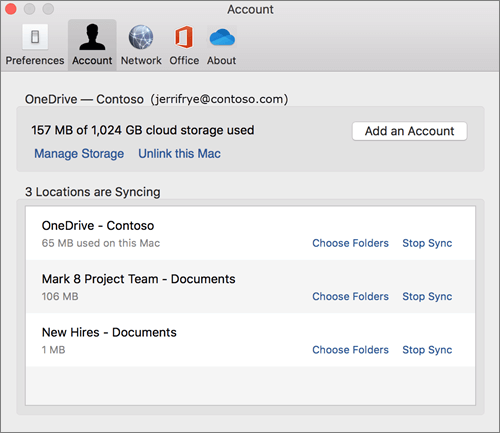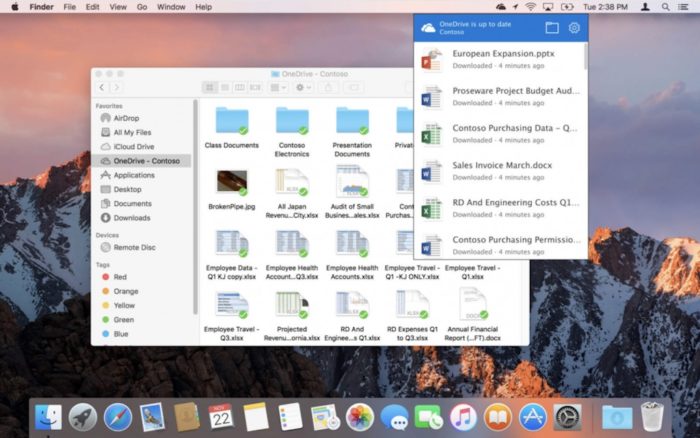
- #Onedrive macos 10.13 download install#
- #Onedrive macos 10.13 download update#
- #Onedrive macos 10.13 download upgrade#
- #Onedrive macos 10.13 download pro#
- #Onedrive macos 10.13 download code#
Creates a disk image and names it with the appropriate information for the specified macOS installer.Ħ.

Once you’ve selected from the available options, the script does the following:Ĥ. Identify the listed products which appear to be macOS installers.ģ.
#Onedrive macos 10.13 download update#
Parse a specified Software Update feed.Ģ. Processing steps citation from reference #2 below: 1.
#Onedrive macos 10.13 download code#
From my point of view, the code is the opposite ofīeing opaque with some basic Python knowledge you can read through the codeĪnd get the ideas behind. Scans Apple´s regular Software Update catalogs and is able to create a wide It is an open source tool of about 600 lines written in Python. Some comments on the installinstallmacos.py script
#Onedrive macos 10.13 download pro#
MacBook Pro Early 2015 running OS X 10.11.6 El Capitan.

Ran without any problems and took somewhat less that an hour. MacOS High Sierra 10.13.6 where this clone resides on another external HD īoth HDs connected to the machine via a USB 3 hub.
#Onedrive macos 10.13 download upgrade#
Upgrade a clone of the Macintosh HD with OS X 10.11.6 El Capitan to Now we can create the bootable installer on an appropriate volume: sudo /Applications/Install\ macOS\ High\ Sierra.app/Contents/Resources/createinstallmedia -volume /Volumes/volume_to_contain_high_sierra_installer -applicationpath /Applications/"Install macOS High Sierra.app"įor test: Boot into the newly created installer residing on an external HD and
#Onedrive macos 10.13 download install#
app file into /Applications which, in our case, is Install macOS High Sierra.app We now open the sparseimage by DiskImageMounter (via Finder) and drag the installer. Run sudo python /path_to/installinstallmacos.py -catalogurl -raw

rw-r-r- 1 user staff 269647 '/macOS Install Data/OSX_10_13_IncompatibleAppList.pkg' rwxr-xr-x 1 root wheel 23520 Dec 1 12:37 '/macOS Install Data/Locked Files/cleanup_installer' rw-r-r- 1 root wheel 3557 Jan 8 07:38 '/macOS Install Data/Locked Files/.disk_label_2x' rw-r-r- 1 root wheel 15 Jan 8 07:38 '/macOS Install Data/Locked Files/.disk_ntentDetails' rw-r-r- 1 root wheel 893 Jan 8 07:38 '/macOS Install Data/Locked Files/.disk_label' rw-r-r- 2 user wheel 1584 Dec 4 19:09 '/macOS Install Data/ist' rw-r-r- 1 user staff 4706541399 Dec 4 19:09 '/macOS Install Data/InstallESDDmg.pkg'

rw-r-r- 1 user staff 2124 Jan 8 08:39 '/macOS Install Data/index.sproduct' rw-r-r- 1 user staff 478740408 Dec 4 19:04 '/macOS Install Data/BaseSystem.dmg' rw-r-r- 1 user staff 1948 Dec 4 19:03 '/macOS Install Data/BaseSystem.chunklist' rw-r-r- 1 user staff 2613173 Dec 4 19:03 '/macOS Install Data/AppleDiagnostics.dmg' rw-r-r- 1 user staff 328 Dec 4 19:03 '/macOS Install Data/AppleDiagnostics.chunklist' Before doing that, inspect the download directory: sudo find /macOS\ Install\ Data -type f -exec ls -l \ When the download is complete, the installer will prompt for a system restart. After that, it will begin downloading to "/macOS Install Data" on the local machine. Click "Continue", accept the licensing agreement, select the install drive, then the installer will prompt for an admin password. It will launch "Install macOS High Sierra" after the download completes. From the App Store, grab the High Sierra installer.


 0 kommentar(er)
0 kommentar(er)
